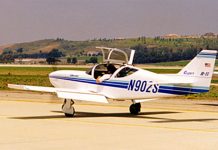As FAA and National Transportation Safety Board reports can take up to one year to be published, advanced publication of accidents in this column do not contain alt the facts and information necessary to draw definitive conclusion. Rather, these accident briefs are intended to bring the circumstances to the attention of Glasair builders in the interest of improving safety. They are not intended to judge the ability or capacity of any person, living or dead, or any aircraft or accessory. We appreciate the willingness of Glasair builders to share their experiences with others so they may have the opportunity of avoiding similar circumstances.
We are happy to report that there were no injury accidents this quarter. However, we do have some accidents that should be mentioned.
Brake Causes Flip Over
According to the owner/pilot, he was taxing out to go flying in his Glasair I FT, when the left brake went flat. Due to a strong quartering tailwind, he could not get the aircraft slowed down. As he entered the grass off the side of the taxi way, the aircraft began to turn to the right. In an attempt to correct the problem, he goosed the power and held full left rudder. This tipped the aircraft up on its nose. The prop hit the ground and seemed to help flip the aircraft over on its back. The pilot escaped through an open canopy, uninjured. Damage was a bent fixed pitch propeller, broken windshield, broken windshield bow, broken gull-wing canopy, and damaged rudder counterweight. The cause was a brake caliper piston that popped out, due to the brakes being worn down to far.
Fuel Spill Ignites
Another accident occurred after a Glasair II FT was refueled on a level ramp. The pilot entered the aircraft and attempted to start the engine. He heard a pop and shortly there after, discovered that the ground under the aircraft was on fire due to fuel that had been spilled onto the ramp. He then ran into an adjacent hangar to get help in putting out the fire. The aircraft was severely damaged before the fire was extinguished.
Propeller Overspeed
A Glasair III owner reported that he was flying his aircraft over his home airport and pushed the nose down on the airplane to a negative “G” situation. The engine abruptly went into an overspeed condition. The airplane was immediately landed and an inspection showed significant damage to the propeller hub. The airplane was built up as an acrobatic plane with provisions for inverted operation. However, because of the lack of availability, the propeller was not a counterweighted type to prevent an overspeed situation should there be a loss of oil pressure, nor was an accumulator installed to keep oil pressure to the propeller governor during momentary pressure losses.
Unexpected Take Off
Another Glasair III had severely damaged the undercarriage after a high-speed taxi mishap. The builder was in the taxi testing stage and was making high speed taxi runs down the runway. At first his attention was focused on the airspeed indicator. When he suddenly found himself airborne, he pulled power to put it back on the ground. The torque factor that he was countering during acceleration was not easily anticipated as he pulled the power. He had been accustomed flying a Cherokee six with a lower power to weight ratio. This may have caused some over controlling as the aircraft settled back to the ground. As a result, he contacted the side of the runway which pulled the aircraft into rough terrain which resulted in the damaged landing gear.
This is not the first time that an accident has happened from an unexpected take off during taxi testing. If you should find yourself in such a situation in the future, it is safer to continue flying around the pattern and make a normal landing under more controlled circumstances and with extra runway in front of you. For this reason, it is also important that the aircraft is airworthy, as well as the pilot, prior to beginning any taxi testing.
I commend the builder involved for his willingness to share this incident with others so that we may all learn from it. It says a lot about the excellent character that we find amongst our customers.
Conclusion
It is very important that all pilots have a good understanding of their aircraft systems and how they work. Knowing the aircraft systems and what their limitations are is as big a part of flying as the skill of making a good landing. Spend the time to get familiar and don’t take unnecessary risks. Take your time during your preflight to be sure the aircraft is airworthy and ready to give you maximum enjoyment. Take care of it and it will take care of you.



